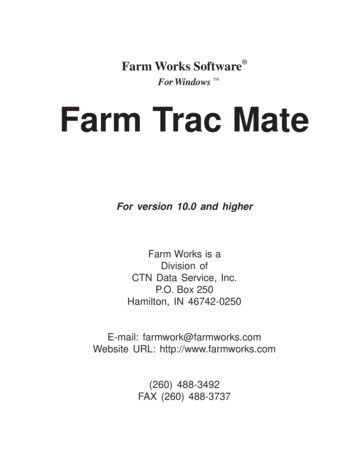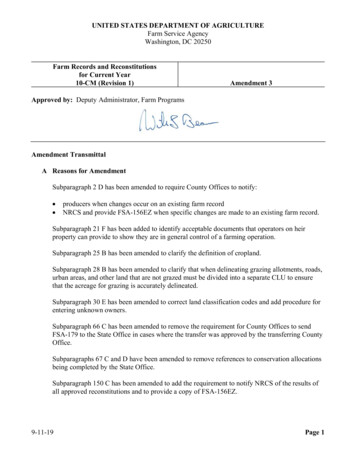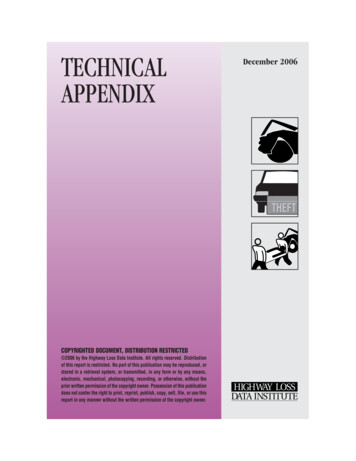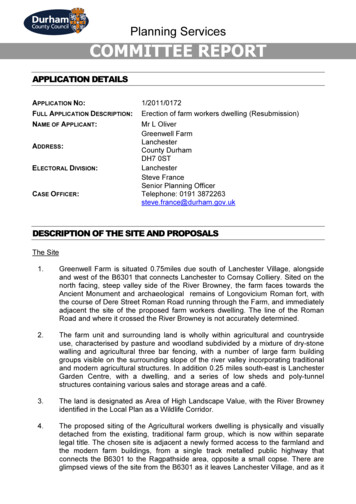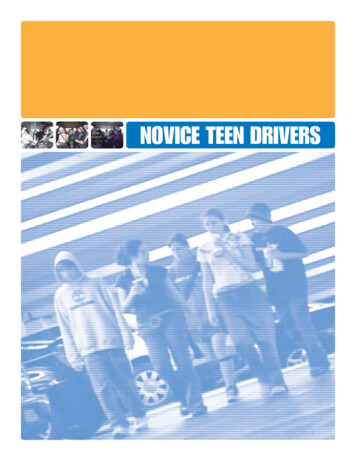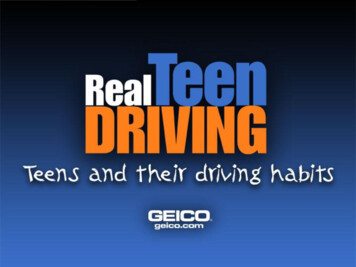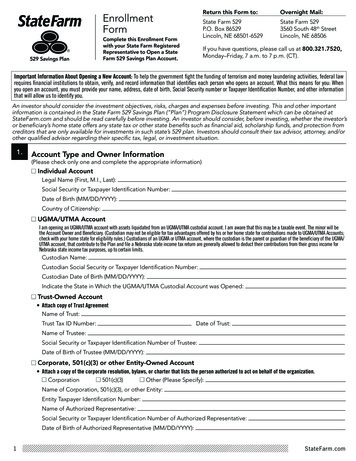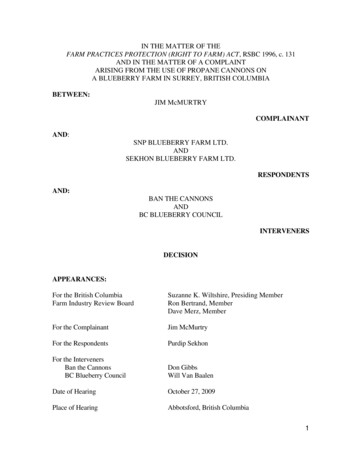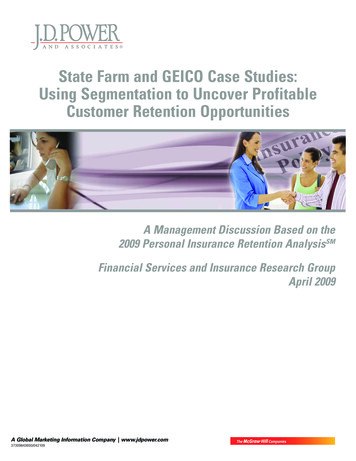
Transcription
State Farm and GEICO Case Studies:Using Segmentation to Uncover ProfitableCustomer Retention OpportunitiesA Management Discussion Based on the2009 Personal Insurance Retention AnalysisSMFinancial Services and Insurance Research GroupApril 2009A Global Marketing Information Company www.jdpower.com37309843650/042109
State Farm and GEICO Case Studies: Using Segmentationto Uncover Profitable Customer Retention OpportunitiesRetaining Auto and Homeowners Insurance Customers in aSlowing EconomySales of new light vehicles in the United States have historically been sensitive to theups and downs of overall economic conditions. Meanwhile, the personal auto insurancemarket has been remarkably stable during the past 5 years (Figure 1), according to financialdata from Standard and Poor’s.1In this mature market, individual insurance companies tend toward a zero-sum game,where the growth of one company comes at the expense of another. To grow, an insurermust both protect its current book of business and conquest new customers. Giventhe significant cost involved in acquiring new policyholders, personal auto insurers havetraditionally focused their efforts on maximizing policyholder retention—especially amongthose customers they view to be the most valuable, whether in the short or long term.The current U.S. economic recession, which most experts agree began in December 2007,has heightened the importance of customer retention. Insurers are working to shore uptheir retention rates as well as financials in the face of lackluster investment performance.—5-Year Personal Auto Industry Premium Trend—170 in Billions16516116216516520062007163160The current U.S. economicrecession, which most expertsagree began in December 2007,has heightened the importance ofcustomer retention.155150200320042005YearFigure 1Source: Standard and Poor’s, based on statutory findingsFor the past 5 years, J.D. Power and Associates has published average customer retentionrates for each of the top insurers in the U.S. personal auto and homeowners insurancemarkets. The J.D. Power and Associates 2009 Personal Insurance Retention AnalysisSMis based on surveys gathered from more than 275,000 auto insurance customers. Thesurvey was fielded from January to March 2009 and benchmarks 32 of the nation’slargest personal auto insurers. (See Appendix for a complete list of profiled insurers.)The complete retention analysis, which provides segmented retention performance anddefection patterns for each of these profiled insurers, will be available by subscription tothe J.D. Power and Associates 2009 Insurance Shopping Study,SM which will publish inJune 2009. 2009 J.D. Power and Associates, The McGraw-Hill Companies, Inc. All Rights Reserved.2
State Farm and GEICO Case Studies: Using Segmentationto Uncover Profitable Customer Retention OpportunitiesThis Management Discussion includes an examination of some of the pronouncedvariations in customer retention performance between customer segments of two nationalinsurers, GEICO and State Farm, which will demonstrate the kinds of opportunities the fullanalysis will identify for each of the profiled insurers. In addition, a financial model and theunderlying assumptions are used in a number of instances to estimate the incrementalpremium that select insurers may realize if they successfully apply targeted strategies toimprove retention for segments of their book.Industry Retention TrendsFor the industry overall, auto policyholder retention has remained fairly stable at close to89% during the past 5 years, according to J.D. Power and Associates’ research. However,individual insurer performance is more volatile. For example, Progressive has madesignificant strides in improving customer satisfaction and retention during the past 5 yearswhile AIG has suffered significant setbacks during the past year, presumably as a result oftheir highly publicized financial challenges and related government assistance. (Figure 2)—Personal Auto Retention Rate Trend—Annual Retention Rate100%Industry90%State FarmGEICO80%ProgressiveAIG70%Allstate60%50%2007 – 2008Year2008 – 2009Figure 2Source: J.D. Power and Associates 2008 Insurance New Buyer and 2009 Insurance Shopping StudiesSMIn segmenting auto insurance customers based on purchase behavior, there has been aremarkably stable 12% difference in the retention rates of households that bundle auto andhomeowners insurance from the same insurer, compared with monoline auto insurancecustomers (95% vs. 83%, respectively, this year). This phenomenon was explored indetail in the J.D. Power and Associates 2008 Insurance Shopping StudySM ManagementDiscussion, “Winning and Losing Customers in Personal Auto Insurance.”2Examining policy retention by generational cohort reveals that Baby Boomers (born between1946 and 1963) renew at a significantly higher rate (92%), compared with Generation X(born from 1964 to 1984) or Generation Y (born from 1985 to 1991) customers, who renewat rates of 88% and 80%, respectively. Pre-Boomers (born before 1946) renew at thehighest rate, 93%. 2009 J.D. Power and Associates, The McGraw-Hill Companies, Inc. All Rights Reserved.3
State Farm and GEICO Case Studies: Using Segmentationto Uncover Profitable Customer Retention OpportunitiesThe Relationship between Customer Satisfaction and RetentionSince 2005, J.D. Power and Associates has tracked the relationship between customersatisfaction, customer retention, and profitability for each of the nation’s largest insurers.(Figure 3) These analyses reveal a significant financial benefit to each insurer of increasingcustomer satisfaction, one customer at a time. Simultaneously, J.D. Power and Associates’research in the personal auto insurance marketplace highlights numerous performanceimprovement opportunities and their impact on customer satisfaction.The value that a personal automotive insurance customer represents to their insurer isusually realized over the long term. For many insurers, individual customers do not becomeprofitable until their third or fourth year of tenure—after the insurer recoups the costsassociated with acquiring that new customer. Therefore, the extent to which insurers arebetter able to retain current customers has a direct impact on their bottom-line profitability.—Auto Insurance Study Index vs. Retention—Annual Retention Rate100%90%For many insurers, individualcustomers do not become profitableuntil their third or fourth year oftenure—after the insurer recoupsthe costs associated with acquiringthat new customer.80%70%60%740760780800820840860880900Auto Insurance Study IndexFigure 3Source: J.D. Power and Associates 2008 National Auto Insurance and 2009 Insurance ShoppingStudiesSM. Each data point represents the average 2008 satisfaction index score and 2008-2009retention rate for one of the 26 separate insurance companies profiled in the 2009 InsuranceShopping StudySM. 2009 J.D. Power and Associates, The McGraw-Hill Companies, Inc. All Rights Reserved.4
State Farm and GEICO Case Studies: Using Segmentationto Uncover Profitable Customer Retention OpportunitiesCase Studies: State Farm vs. GEICOLike the industry as a whole, both GEICO and State Farm are better able to retain oldercustomers than younger customers. (Figure 4) Comparing the two insurers, State Farmhas higher retention rates across all generational groups and is able to retain Generation Ycustomers (88%) almost as well as GEICO retains Baby Boomers (90%). However, GEICO’sretention rate among Generation Y customers underperforms the industry at only 78%.To estimate the financial impact of increased customer retention, J.D. Power andAssociates has developed a model based on conservative estimates of policy growth,profitability, and premium growth.3 Using this model, if GEICO could halve the GenerationY retention gap with State Farm, the improvement could yield more than half a billiondollars of additional premium over a 5-year period.4—Customer Generation and Retention—Retention Rates0 – 79%80 – 84%85 – 89%90 – 94%Industry AverageGen YPre-BoomersBoomersGen XGEICOPre-BoomersGen YBoomers95 – 100%State FarmPre-BoomersBoomersGen YGen XProgressivePre-BoomersGen YBoomersGen XGen XFigure 4Source: J.D. Power and Associates 2009 Insurance Shopping Study SM 2009 J.D. Power and Associates, The McGraw-Hill Companies, Inc. All Rights Reserved.5
State Farm and GEICO Case Studies: Using Segmentationto Uncover Profitable Customer Retention OpportunitiesState Farm Retention Driven by BundlingThe most recently available financials for insurers, which are for the 2007 calendar year,5indicate State Farm is the largest personal auto insurer with an 18% share of the U.S.market, while GEICO is the fourth-largest personal auto insurer with a 7% share. Bothinsurers performed at or above the industry average in the J.D. Power and Associates2008 National Auto Insurance Study SM 6 which measures customer satisfaction. While StateFarm successfully retained 94.3% of its personal auto insurance customers from February2008 to February 2009, in contrast, GEICO retained only 87.3% of their personal line autobusiness on an annual basis, significantly below the industry average of 89.6%. (Figure 5)Based on findings in the J.D. Power and Associates 2008 Insurance New Buyer Study,SM 7more than one in five (22%) new insurance buyers reported switching from purchasingauto insurance via an Agent to purchasing via Direct, whereas only 15% made the oppositeswitch. GEICO, a Direct writer, benefits from this change in purchasing habits. As youngercustomers gravitate toward online buying for a growing number of purchases and financialtransactions, it is not unexpected to find Direct writers—such as GEICO, Progressive, andEsurance—gaining a larger share of Generation Y customers, compared with State Farm.—Retention Rates by Segment—GEICOState FarmBundled – Auto and HomeownersN/A97%Bundled – Auto and RentersN/A94%Monoline (Auto only)87%88%Non-Bundled – Homeowners88%88%Non-Bundled – Renters85%76%More than one in five (22%)new insurance buyers reportedswitching from purchasing autoinsurance via an Agent to purchasingvia Direct, whereas only 15% madethe opposite switch.Figure 5Source: J.D. Power and Associates 2009 Insurance Shopping Study SMState Farm and GEICO differ not only in their distribution models, but also in their coreproduct offerings. One of State Farm’s competitive advantages in retaining auto insurancecustomers is its broad range of product offerings, including homeowners insurance,umbrella coverage, and financial products. Looking solely at monoline auto policy retention,GEICO and State Farm have very similar retention rates among these monoline customers.(Figure 5)However, GEICO performs better at retaining non-bundled renters, compared with StateFarm. While a rental insurance policy represents less profit for the insurer or commissionfor a sales agent compared to a typical auto policy, the future long-term value that sucha policyholder represents can be significant, especially once they move from renting toowning a home or other dwelling. The insurers that hold the auto policies for this grouphave an advantage in transforming monoline auto policyholders into bundled policyholders,which translates to more brand loyal and profitable customers. GEICO has difficultymatching the kind of loyalty performance demonstrated by State Farm among bundledpolicy customers. (Figure 5)If State Farm could successfully cross-sell rental insurance policies to just half theirmonoline auto customers who currently buy rental policies from other insurers, theimprovement in retention for this group could generate approximately 50 million inadditional premium revenue during the first year alone, and as much as 600 million ofadditional premium revenue during a 5-year period. This is based on the premise that noneof the underlying assumptions change.8GEICO is particularly strong at peeling away the monoline auto business of customerswho are shopping for bundled auto and homeowners policies.9 Furthermore, only 40%of GEICO monoline customers who entertain competitive offers defect from GEICO, 2009 J.D. Power and Associates, The McGraw-Hill Companies, Inc. All Rights Reserved.6
State Farm and GEICO Case Studies: Using Segmentationto Uncover Profitable Customer Retention Opportunitiescompared with 49% for State Farm. Thus, a portion of GEICO’s recent growth isattributable to the fact that they can capture auto policy sales from those shopping formonoline or bundled policies. GEICO is also better able to retain these customers if theyentertain a competitive quote after becoming insureds. However, the risk of State Farm’smonoline auto customers defecting is mitigated by the fact that only 23% have shoppedfor auto insurance during the past 12 months, compared with 33% of monoline GEICOcustomers. If State Farm monoline auto customers shopped at the same rate as GEICOcustomers, and all other considerations remained the same, the additional attrition couldcost the company an estimated 2 billion in lost premium during a 5-year period.10Defection PatternsSince no insurer retains all of their auto insurance customers during the course of a year,it’s important to understand where the defectors are going. Across the industry as awhole, GEICO captured an estimated 15% of all defectors who switched insurers betweenFebruary 2008 and February 2009, which helps to fuel the company’s growth, given amarket share of only 7%.11 State Farm, by comparison, captures only 9% of defectors,despite an 18% share of the personal auto insurance market.12When looking at brand-to-brand defections, Allstate succeeds in conquesting GEICO andState Farm customers at a rate 1.5 times greater than their overall industry conquest rate.Comparing State Farm and GEICO, State Farm conquests only one-in-ten GEICO defectorswhile GEICO in turn captures State Farm defectors at nearly twice the rate.—Where Are Defectors Going?—Industry AverageDefectors15.4%Brand Defected ToGEICO11.1%Progressive9.0%State State FarmDefectorsN/AState e Farm12.7%17.8%11.2%N/AAllstate20%11.9%0%10%20%% of Customers Defecting to Each InsurerFigure 6Source: J.D. Power and Associates 2009 Insurance Shopping Study SM 2009 J.D. Power and Associates, The McGraw-Hill Companies, Inc. All Rights Reserved.7
State Farm and GEICO Case Studies: Using Segmentationto Uncover Profitable Customer Retention OpportunitiesConclusionThe findings in this Management Discussion serve to demonstrate the variations incustomer retention rates evident within each insurer’s book of business when segmentingcustomers by demographic and attitudinal traits. For each insurance company examined inthe full analysis for the 2009 Insurance Shopping Study, there exist groups of customersfor whom the insurer is less competitive in retaining their policies. Insurers that areable to identify profitable customer segments with room for retention improvement candevelop strategies that are more effectively tailored around these customers’ individualneeds.The forthcoming full analysis delves further into customer segments and profilespsychographic traits such as early technology adoption, affinity for financial markets, andadditional demographic traits such as gender, ethnicity, and education, among others. Thisanalysis is available by subscription to J.D. Power and Associates 2009 Insurance ShoppingStudy.SMFootnotes:1Standard and Poor’s, based on statutory filings (reported in 2008).2Available for download at: www.jdpower.com/corporate/library/download/?files 9998902.3Financial premium forecasts assume no change in new business production; and 3%annual growth in premium per policy.4Ibid.5A.M. Best 2007 Insurance Industry Financials based on statutory filings (reported in 2008).6J.D. Power and Associates 2008 National Auto Insurance Study.SM7J.D. Power and Associates 2008 Insurance New Buyer Study.SM8Financial premium forecasts assume no change in new business production; and 3%annual growth in premium per policy.9J.D. Power and Associates 2008 Insurance New Buyer Study.SM10Financial premium forecasts assume no change in new business production; and 3%annual growth in premium per policy.11A.M. Best 2007 Insurance Industry Financials based on statutory filings (reported in 2008).12Ibid.Authors:Stephen CrewdsonSenior Research ManagerStephen Crewdson@jdpa.comJay Meyers, Ph.D.Director, Marketing SciencesJay.Meyers@jdpa.comJeremy BowlerSenior DirectorJeremy.Bowler@jdpa.comColleen CairnsResearch SupervisorColleen.Cairns@jdpa.com 2009 J.D. Power and Associates, The McGraw-Hill Companies, Inc. All Rights Reserved.8
State Farm and GEICO Case Studies: Using Segmentationto Uncover Profitable Customer Retention OpportunitiesAppendix (List of Profiled Insurers) 21st Century GEICO Auto Club Group GMAC Auto Club of Southern California Hanover AIG The Hartford Allstate Liberty Mutual American Family Mercury Ameriprise MetLife Amica Mutual Nationwide Auto-Owners New Jersey Manufacturers Commerce Progressive Country Mutual Safeco California State Auto Association State Auto Encompass State Farm Erie Insurance Travelers Esurance Unitrin Direct Farmers USAA 2009 J.D. Power and Associates, The McGraw-Hill Companies, Inc. All Rights Reserved.9
Turning Information Into Action About J.D. Powerand AssociatesJ.D. Power and Associates isa global marketing informationservices company operating in keybusiness sectors across a varietyof industries including marketresearch, forecasting, performanceimprovement, Web intelligence,and customer satisfaction.Established in 1968, the companyhas been listening to consumersand business customers; analyzingtheir opinions and perceptions; andrefining research techniques andstudy methodologies to offer someof the most advanced productquality, customer satisfaction,and tracking research availabletoday. The company’s quality andsatisfaction measurements arebased on responses from millionsof consumers annually. J.D. Powerand Associates is a business unitof The McGraw-Hill Companies.Custom ResearchJ.D. Power and Associates conducts customized research and customer satisfactionmeasurement and tracking on a proprietary basis. J.D. Power has been conducting proprietaryresearch in the areas of quality and customer satisfaction for four decades.J.D. Power and Associates conducts custom research studies across numerous industries,utilizing a variety of data collection methods. These studies dive deep into each stage of thecustomer life cycle, thus enabling management to understand the customer experience andprioritize improvement opportunities to enhance that experience.To learn more about our products and our services, please visit: www.jdpower.com/corporateCertification ProgramsJ.D. Power and Associates certification programs help consumers and B2B customers identifyproduct and service providers that deliver an outstanding customer experience. In orderto become certified, the client company must meet or exceed the customer satisfactionbenchmark established by the most recent J.D. Power and Associates research study in thatindustry. Companies that become certified may then have the opportunity to license theJ.D. Power brand to enhance consumer recognition of their certification. The company offerscertification for the following: Automotive Retail Dealerships Call Centers Hospitals Hotels Insurance Agencies New Home-Builders Technology Support OperationsTo learn more about these certification programs, please visit: www.jdpower.com/corporate/awards/certificationWeb IntelligenceThe J.D. Power and Associates Web Intelligence Research Division offers a breakthroughcapability to analyze social media—to provide richer and deeper insights about topics ofmost importance to online content creators. J.D. Power Web Intelligence crawls more than70 million blogs each week and collects unaided opinions of the online community—turningit into valuable marketing intelligence about markets, trends, issues, segments, brands,products, and services. This capability not only delivers feedback in the form of data, but alsoprovides insights into the online dialogue that millions of consumers conduct on a daily basisvia blogs, message boards and other forms of online content.To learn more about our products and our services, please visit: www.jdpower.com/corporate/webintelReproduction of any material contained in this publication, including photocopying of this publication in whole or in part, is prohibited without the expresswritten permission of J.D. Power and Associates. Advertising claims cannot be based on information published in this J.D. Power and Associates 2009 PersonalInsurance Retention Analysis.SMDetailed retention, conquest, and growth data for the major insurers listed in the Appendix are presented in the full analysis included in the J.D. Power andAssociates 2009 Insurance Shopping Study,SM to be published in June 2009. 2009 J.D. Power and Associates, The McGraw-Hill Companies, Inc. All Rights Reserved.10
GEICO and State Farm have very similar retention rates among these monoline customers. (Figure 5) However, GEICO performs better at retaining non-bundled renters, compared with State Farm. While a rental insurance policy represents less profit for the insurer or commission

